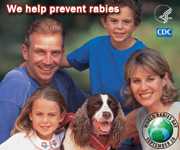What type of exposure occurred?
Rabies is transmitted only when the virus is introduced into a bite wound, open cuts in skin, or onto mucous membranes such as the mouth or eyes.
Other factors to consider when evaluating a potential rabies exposure include the natural occurence in the area, the biting animal’s history and current health status (e.g., abnormal behavior, signs of illness), and the potential for the animal to be exposed to rabies (e.g., presence of an unexplained wound or history of exposure to a rabid animal).
A currently vaccinated dog, cat, or ferret is unlikely to become infected with rabies.
When an exposure has occurred, the likelihood of rabies infection varies with the nature and extent of that exposure. Under most circumstances, two categories of exposure — bite and nonbite — should be considered.
Bite
Any penetration of the skin by teeth constitutes a bite exposure. All bites, regardless of body site, represent a potential risk of rabies transmission, but that risk varies with the species of biting animal, the anatomic site of the bite, and the severity of the wound.
Bites by some animals, such as bats, can inflict minor injury and thus be difficult to detect.
Was the bite from a provoked or an unprovoked attack? Bites inflicted on a person attempting to feed or handle an apparently healthy animal should generally be regarded as provoked. If it was an unprovoked attack, that’s more likely to indicate that the animal is rabid.
Nonbite
The contamination of open wounds, abrasions, mucous membranes, or theoretically, scratches (potentially contaminated with infectious material from a rabid animal) constitutes a nonbite exposure.
Nonbite exposures from terrestrial animals rarely cause rabies. However, occasional reports of rabies transmission by nonbite exposures suggest that such exposures should be evaluated for possible postexposure prophylaxis administration.
Other contact by itself, such as petting a rabid animal and contact with blood, urine, or feces of a rabid animal, does not constitute an exposure and is not an indication for postexposure vaccination.
- Page last reviewed: April 22, 2011
- Page last updated: April 22, 2011
- Content source:





 ShareCompartir
ShareCompartir